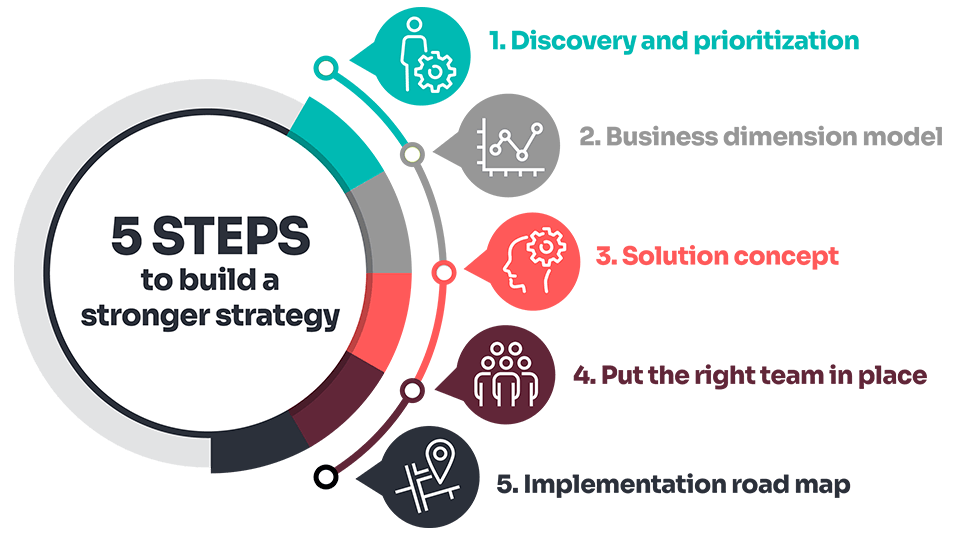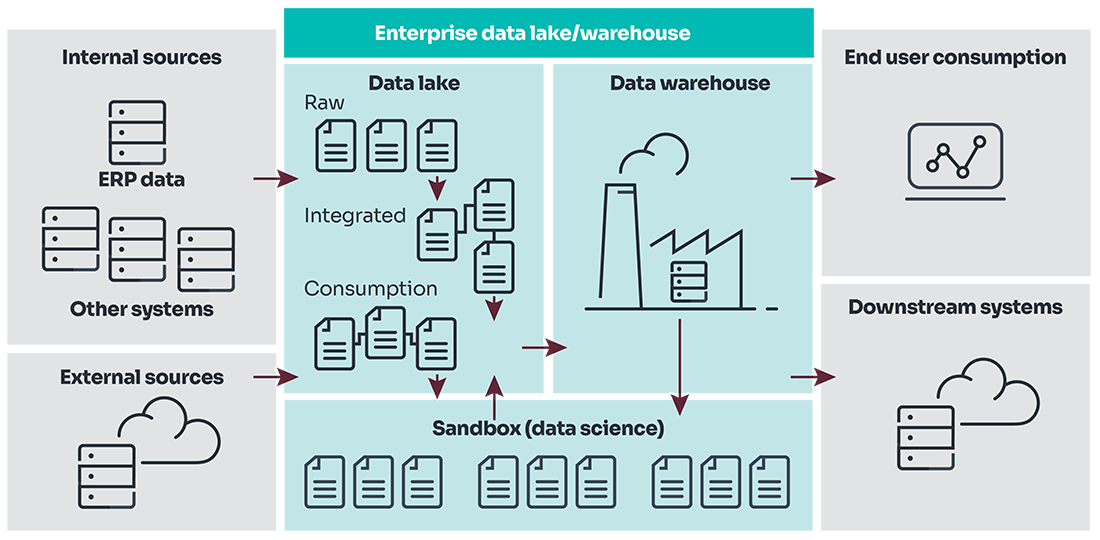
Data Solutions
Data Solutions

Micheal Herman
Principal

Dave DuVarney
Principal

Rob Long
Principal

Jordan Anderson
Director

Matt Pluster
Director

Ann E. Blakely
Managing Principal

John Runte
Principal
Is your business equipped with the right data solutions to effectively and efficiently capitalize on the mountains of data available to you?
At Baker Tilly, our digital team helps our clients derive new value from their data, whether it’s through advanced machine learning, data visualization or working to implement new data processes for a “single source of truth.”
Every day, companies like yours are trying to use their data to make the best decisions possible, which means having the right data programs in place is quite literally the difference between success and failure. With so much riding on each project, we make sure to bring leading data strategy, technical expertise and business acumen to each of our data services.

In the diagram above, the outer ring, comprised of data strategy and data governance, focuses on the strategic and operational needs a company has when building a data-driven culture.
The inner ring, comprised of data modernization, visualization and advanced analytics, illustrates the technical tools, platforms and models used to execute against the strategies and policies created in the outer layer.
Data solutions are the key to insight and decision making
- Innovation at scale: Want to read your customers’ minds? It’s not telepathy; it’s data analytics. Equip your organization with the right data and the ability to adapt and scale, so you’ll know what your customers want before they ask you for it.
- Data-driven decision making: Empower your business leaders with data-backed insights, enabling decisions that are timely, informed, and predictive of market trends.
- Risk management: Proactively manage risks by interpreting data patterns that signal potential threats, allowing for preemptive action to secure your business interests.
- Enhanced efficiency: Streamline your operations with modern platforms that are optimized for peak performance, saving you time, money and resources.
- Growth strategy and competitive advantage: Uncover opportunities for innovation, optimize marketing and drive greater earnings by uncovering new insights about your most profitable products, services and customers.
Data strategy is much bigger than adopting a tool, it’s about building a strong and lasting capability within the business. Knowing what to measure, having processes in place for measuring efficiently at scale, organizing the right people and implementing the right tools and technology are all central to designing an effective data strategy.
The benefits of a strong data strategy can be felt across the company
A focused business is an efficient one. Companies who create a shared language and understanding around their data will know what the key indicators are, what they mean and why they're important to the business.
1. Create focus and efficiency
With everyone in the company on the same page about what’s important and why it matters, efficiency can blossom.
2. Make better decisions
Get the data you need from within your business immediately instead of waiting for teams to produce manual reports with potentially conflicting results.
3. Enjoy stronger market advantage
Anticipating what will happen instead of reacting after the fact gets you out in front of the competition.
Five steps to build a stronger strategy

1. Discovery and prioritization
We audit your existing materials and stakeholder interviews across key divisions within the company (sales, marketing, finance) to understand and prioritize the questions they would like data to help answer. The questions are aggregated and organized into themes before we work with you to score the business value of measuring a specific theme, against the feasibility of being able to measure it.
2. Business dimension model
Our business dimensional matrix takes the prioritized themes and breaks down the different dimensions they can measure and variables they measure them by. The intersecting rows source where the necessary data will come from.
3. Solution concept
Once we’ve prioritized the data domains we to want to address, we work with the individual business leads to design the conceptual architecture for ingesting, organizing, connecting and visualizing the data based on what the client’s technology environment can handle. We identify the tools that should be put in place and how they should be laid out, based on the company’s available talent for managing and implementing the program, or the aspirations that they have from a technology platform perspective.
4. Put the right team in place
Next, we help you put the right people and processes in place to execute your solution concept. We recommend filling eight roles within your business (internally and externally), in order for you to be able to utilize your data successfully. These roles include: Executive Sponsor/Steering Committee, Program Manager, Project Manager, Data Architect, Business Analyst, Data Engineer, Data Analyst and Data Scientist.
5. Implementation road map
With our solution concept(s) in place, we create a two- to three-year road map that spells out the data domains the business should address, the foundational elements needed to stand up the capabilities internally, and the timing of each step.
For more information, download our data strategy e-book.
To effectively compete in the modern business world, every company must use their data to gain insights that will accelerate accurate decision-making and advance strategic and operational objectives.
Why data governance is essential
- Increasing data volume from multiple sources: The volume of data available from an increasing number of sources is accelerating faster than companies can manage. Without strong data governance to standardize and manage data across sources, companies miss out on the opportunity to capitalize on the full insight their sources have to offer.
- Self-service reporting and analytics: Many companies implement self-service reporting platforms to shift the burden of report writing away from IT resources. But enabling more individuals to create reports comes with serious risks related to consistency and accuracy.
- Regulatory and compliance requirements: Growing consumer protection concerns are accelerating regulatory standards for sensitive information, which makes protecting data even more critical. Without the proper processes, policies and procedures in place, the company is vulnerable to costly threats.
- Machine learning (ML) and artificial intelligence (AI): Cutting-edge technologies like machine learning and Al are only as effective as the data they use to identify patterns and trends. A governance program will ensure these technologies work to improve the value of the business.
Data governance focus areas
For this to go smoothly, data governance is essential because it serves as the source of truth for all data-related matters. This includes defining and organizing the right data sources, data integrity and security, data ownership and establishing the right policies at each level of the company.
1. Policy, standards and strategy
Move from siloed data usage to a unified enterprise data management approach with cross-functional data stewards to establish and administer policy.
2. Data quality
Address issues with data integrity, usability or quality to improve decision-making, consistency and trust.
3. Privacy, compliance and security
Protect sensitive data, establish access management and security policies to manage risk and comply with evolving regulatory requirements.
4. Architecture/integration
Flawlessly onboard newly acquired systems and seamlessly navigate large IT projects that require advanced levels of cross-functional decision-making and accountabilities.
5. Data warehouses and business intelligence
Institute process and policies to methodically ingest, organize and model data from multiple sources to improve reporting consistency while reducing report preparation time.
6. Management and support
Make confident data related decisions that impact operations and/or compliance efforts.
For more information, download our data governance whitepaper.
Leveraging modern cloud platforms, best-in-class warehousing techniques and the right data models, businesses like yours can derive new value from large and varied data sources, get near real-time analytics and deploy advanced analytical capabilities in a cost-effective manner.
What are data warehouses and data models?
Data is often pulled from tens to hundreds, or maybe even thousands of systems around the business, depending on its size. Most of these data sources contain applications or solutions (web applications, database entry, mobile applications, etc.) with their own way of retaining data. To provide insights for an enterprise-wide business intelligence, analytics or data science effort, the data must be structured in a way that is understandable, accurate and beneficial to the business. Data warehouses and data modeling do just that. A data warehouse takes in data from a variety of sources and serves as a place for both long-term storage as well as data analysis.

The data warehouse becomes a single source of truth for reports, dashboards and exploration of company data. In a cloud environment, it can be highly scalable based on performance and the amount of data available. Data modeling comes into play here, too.
Data models are built to reveal and communicate the critical connections between various sets of data points in an automated fashion, so you can quickly answer key questions about the business.
Maximize the accuracy, insightfulness and impact of your data with a data warehouse
- Improve accuracy: Avoid the errors that come with manual reporting and calculations
- Eliminate redundancy: Greater efficiency comes from not having multiple reports with the same objectives being developed in different areas of the company
- Speed to value: Automate manual user processes for faster access and insight
- Cross domain analysis: With all the data in one place, you can look at the performance of the company across divisions, departments and business units
It’s all about making better decisions at the speed of business or finding yourself becoming obsolete. At Baker Tilly, we have designed a comprehensive service to help you pull all your data sources into one business intelligence solution. Then, using best-in-class software, we can help you see your business in more insightful and reliable ways.
Obtaining the full value of your data visualization
Create insight
Harness the full power of your data with powerful visualizations that reveal vivid insights. First, we’ll connect the right data points in precisely the right way to tell the most relevant and compelling story about the health of the business. Then, we’ll help you with the creative techniques to create meaningful visualizations for your business.
Establish adoption
Allow your staff to thrive by providing the right training. Our team of technical advisors will work with your company to identify and train the right people on how to ingest, organize and model the data, program best-in-class analytics dashboards, and produce reports that answer your company’s most critical questions with the highest degree of accuracy and insight.
Visualization examples

Our data scientists spend each day in industries like yours, focusing intently on the cycle in which your data is ingested, organized and interpreted. Through the use of complex statistical models, algorithms and deep learning processes, we make decision-making easier and more accurate by revealing more significant customer insights, improving internal forecasts, streamlining processes and predicting critical trends.
Step 1: Decision management
Define the goal(s) or problem(s) that needs solving. Once completed, determine and prioritize all the decisions the company makes related to this goal or problem with a decision map. Finally, isolate the data sources related to the prioritized decisions and establish baselines by outlining the KPI metrics.
Step 2: Model development and insights
Create a data quality assessment report to prepare the data for modeling. Once the data is cleaned and organized, our data engineers will shape the data properly for model development. As the models are developed, your original business goal or problem stays in focus, so we can test our hypothesis about the goal or problem using a ML or AI solution.
Step 3: Implementation road map
Once the tests are complete, we’ll have the evidence to know that we have a business decision, the proper quantity and quality of data, and a modeling approach that will provide enhanced business value. At this time, we’ll work with you and your team to develop an implementation road map that suits your business best. The goal is to map out the steps required for embedding the tested model(s) into an operational business process.
For more information, check out our data science whitepaper.

Artificial intelligence
AI technologies and tools are changing the way we work, serve customers and deliver results. To remain competitive, leaders need to understand the business use cases for the types of technologies specific to your industry, the risks they can pose and how you can safely and securely reap the benefits.
How we’re helping businesses like yours leverage data
Our technology alliances

Microsoft
Drive innovation, flexibility and scalability with Microsoft and Baker Tilly.
Snowflake
Baker Tilly helps businesses ask bigger questions about their data, eliminate data silos, accelerate analytics and drive better decisions through Snowflake.
Amazon Web Services (AWS)
Drive business growth with the scalability and flexibility of the cloud.

CDAO Advisory
Chief data and analytics officers (CDAOs) have the complicated task of sorting through their various streams of data to determine what can be used to generate revenue for the business. For most companies, prioritizing data from multiple sources and creating actionable insights can be a challenge. We can help.

















